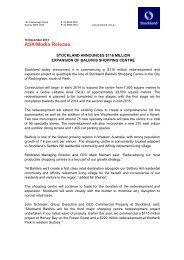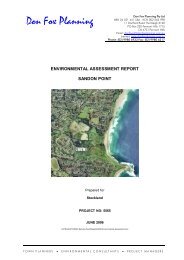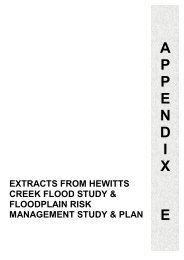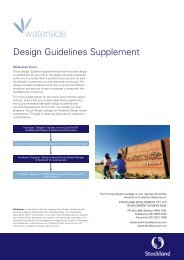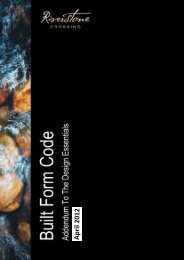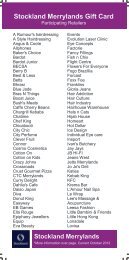Stockland Direct Retail Trust No.1
Stockland Direct Retail Trust No.1
Stockland Direct Retail Trust No.1
You also want an ePaper? Increase the reach of your titles
YUMPU automatically turns print PDFs into web optimized ePapers that Google loves.
<strong>Stockland</strong> <strong>Direct</strong> <strong>Retail</strong> <strong>Trust</strong> No. 1 and its controlled entities<br />
Notes to the Consolidated Financial Statements<br />
For the Year Ended 30 June 2009<br />
20 Financial instruments<br />
(a) Financial risk and capital management<br />
The consolidated entity’s activities expose it to a variety of financial risks: credit risk, liquidity risk, and interest rate risk. The consolidated entity’s overall financial risk management focuses<br />
on the unpredictability of financial markets and seeks to minimise potential adverse effects on the consolidated entity’s financial performance. The consolidated entity uses derivative financial<br />
instruments to hedge exposure to fluctuations in interest rates.<br />
Financial risk and capital management is carried out by a central treasury department under policies approved by the <strong>Direct</strong>ors of the Responsible Entity. The Board provides written principles<br />
of overall risk management, as well as written policies covering specific areas such as managing capital, mitigating interest rate and credit risks, use of derivative financial instruments and<br />
investing excess liquidity.<br />
Capital management<br />
The Responsible Entity’s objective when managing capital is to safeguard the ability to continue as a going concern, whilst providing returns for Unitholders and benefits for other stakeholders<br />
and to maintain a capital structure to minimise the cost of capital.<br />
The Responsible Entity can alter the capital structure of the consolidated entity by adjusting the amount of distributions paid to Unitholders and adjusting the timing of development and<br />
capital expenditure.<br />
In this context, the consolidated entity considers capital to include interest-bearing loans and borrowings and Unitholders’ funds.<br />
Management monitor the capital structure of the consolidated entity through the loan-to-value ratio. The ratio is calculated as the amount of the loan facility drawn divided by the latest valuation<br />
of the consolidated entity’s properties. The loan-to-value ratio as at 30 June 2009 is 72% (2008: 61%) which is not in compliance with the LVR covenant requirement of 70%. On 29 June 2009,<br />
the <strong>Direct</strong>ors received written confirmation from NAB that they will waive their rights to take any action against the <strong>Trust</strong> in relation to the <strong>Trust</strong> not being in compliance with the LVR covenant.<br />
Refer to Note 1(b), 14, and 26 for further detail on the <strong>Trust</strong> not being in compliance with the LVR covenant under the loan facility agreement.<br />
Credit risk<br />
Credit risk is the risk that a customer or counterparty to a financial instrument will default on their contractual obligations resulting in a financial loss to the consolidated entity.<br />
The consolidated entity has no significant concentrations of credit risk and has policies to review the aggregate exposure of tenancies across its portfolio. The consolidated entity also has<br />
policies to ensure that leases are made to customers with an appropriate credit history.<br />
Derivative counterparties are limited to entities with high credit ratings set down by Standard and Poors.<br />
As at 30 June 2009, for the consolidated entity, the aging analysis of total trade receivables is as follows:<br />
2009<br />
Trade<br />
receivables Impairment Net receivables<br />
$’000 $’000 $’000<br />
Not past due 40 – 40<br />
0-30 days past due 17 (7) 10<br />
31-60 days past due 25 (7) 18<br />
61-90 days past due 18 – 18<br />
+91 days past due – – –<br />
100 (14) 86<br />
As at 30 June 2009 and 30 June 2008, there were no significant financial assets that were past due and impaired. As at 30 June 2009 and 30 June 2008, there were no significant<br />
financial assets that would otherwise be past due whose terms have been renegotiated.<br />
20<br />
<strong>Stockland</strong> <strong>Direct</strong> <strong>Retail</strong> <strong>Trust</strong> No. 1 June 2009



